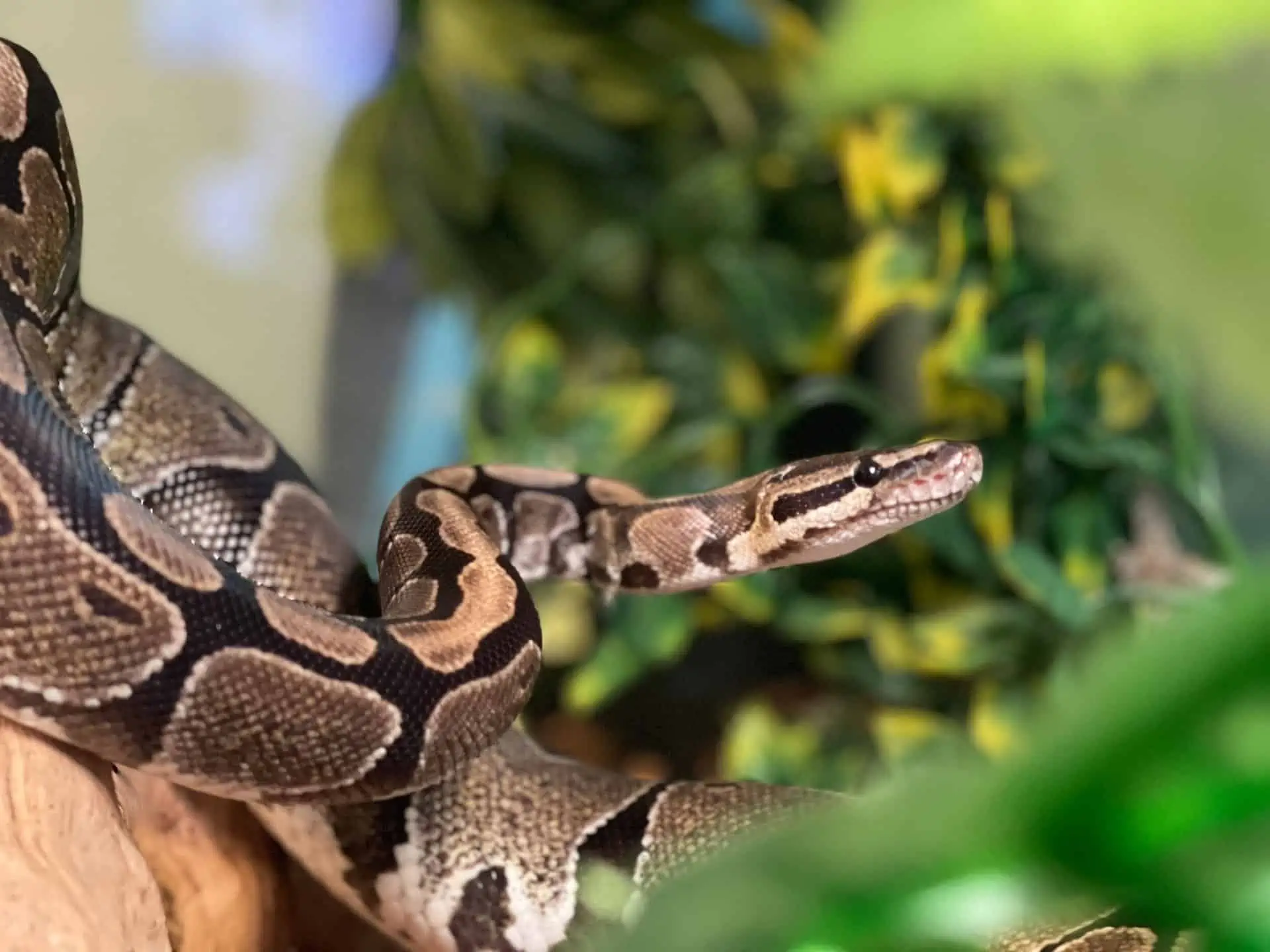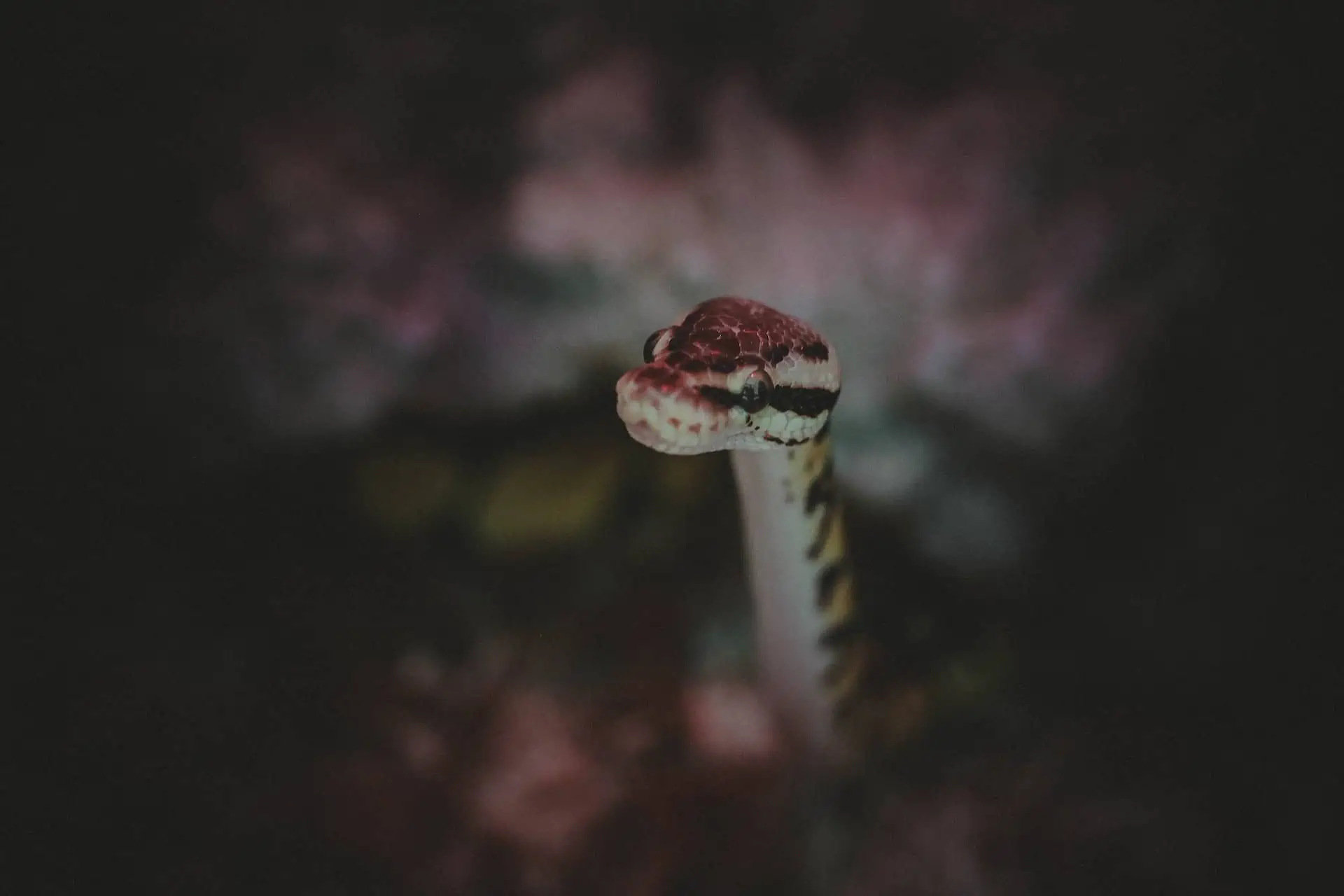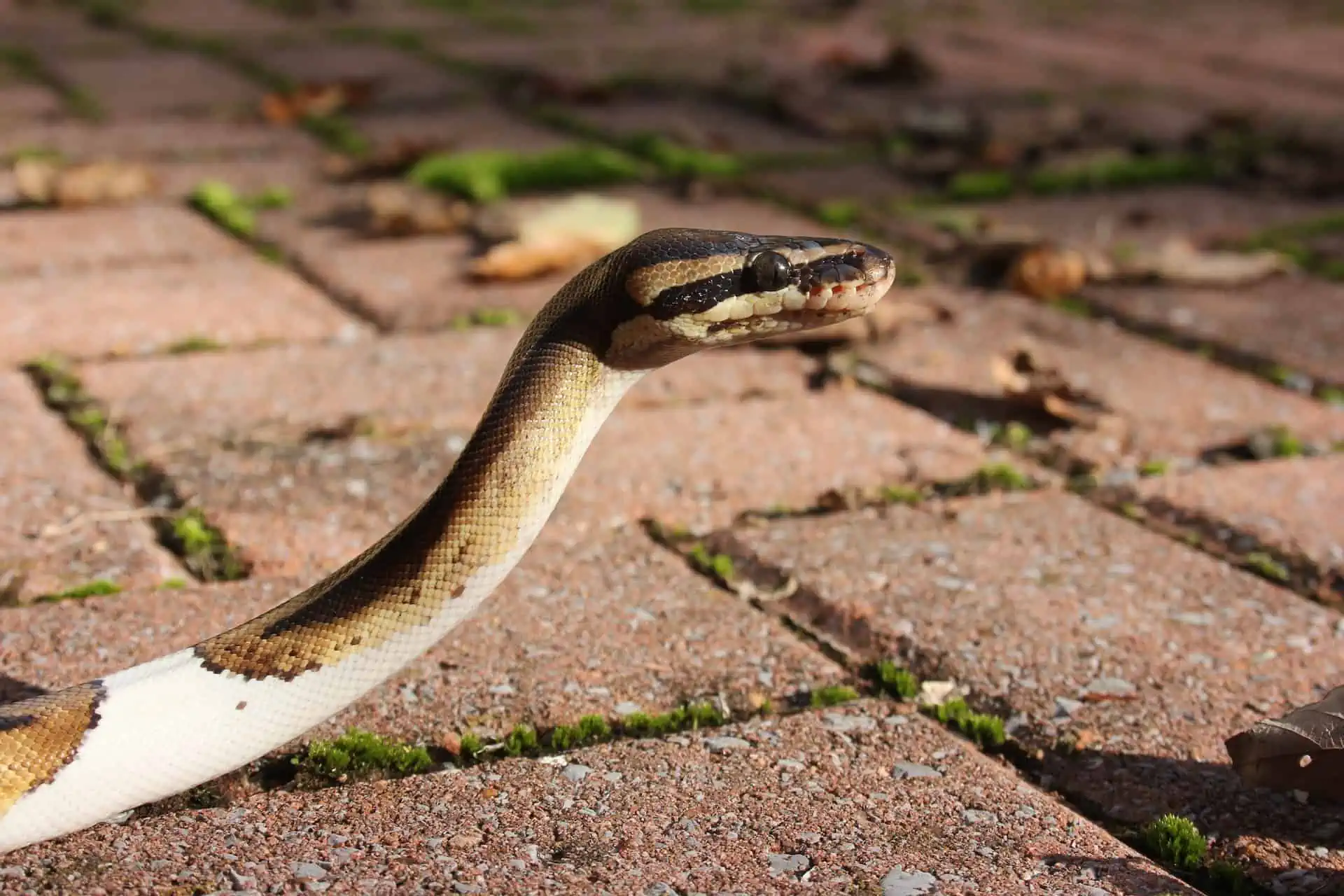As a reptile owner, it is important to know when your ball python is underweight. A healthy ball python should always have a nice round belly, so if you notice your snake is not looking as plump as normal, it could be because they are not eating.
When I took on the case of “Jack,” a two-year-old ball python who had not eaten in more than three months and was dangerously underweight. I knew immediately that something was wrong. In addition to being underweight. He also seemed lethargic and had an overall poor appearance.
But how did I know he was underweight? It’s actually quite easy to spot the signs of an underweight ball python. I’ll tell you what to look for so that if something similar happens with your pet reptile, you’ll know the signs.
How Can I Tell if My Ball Python Is Underweight?
Many pet owners are unsure how to tell if their ball python is underweight. One of the best things you can do is use your hands to feel if your snake is underweight. By feeling its body, you should be able to determine if it’s underweight or not.
Here are some physical signs of an underweight ball python that can help you identify the issue:
- Visible Ribs or Spine: If you can see the ribs and spine of your ball python, then it is likely underweight.
- Sunken Eyes: An underweight snake may have a sunken appearance around its eyes, which gives them a tired or sickly appearance.
- Lethargic Behavior: If your ball python appears more sluggish than usual, it may not get enough food.
- Weight Loss: If you have weighed your snake and noticed that it has lost weight over time, this is a strong sign that it is underweight.
- Poor Skin Condition: An underweight snake may have dry, cracked skin or look dull and faded color.
- Low Energy Levels: An underweight ball python will have lower energy levels than usual and may be less active.
- Reduced Feeding: A healthy ball python should eat one meal a week. If your snake is consistently going off feed, this could be a sign of weight loss.
So if you suspect that your beloved pet is underweight, it is important to take action quickly. Let’s look at some of the possible causes and treatments for an underweight ball python.
Causes of an Underweight Ball Python
There are several possible causes of an underweight ball python. Let’s look at some of the likely culprits:
1. Feeding Problems
Most of the causes of an underweight ball python are related to problems with feeding. If your snake is not eating, it will naturally lose weight. Other signs include:
- Improper Food Presentation: If you are presenting your ball python with food that is not live or moving, it may refuse to eat.
- Incorrect Feeding Schedule: Not providing enough meals or feeding too often can cause your snake to become underweight.
- Poor Diet Quality: Feeding your snake unhealthy food or processed foods can cause it to lose weight.
- Unnatural Diet: An improper diet containing processed foods or even insects that are not part of the natural diet of a ball python can lead to nutritional deficiencies and being underweight.
- Overfeeding: Overfeeding your snake can cause it to become overweight, leading to digestive issues and unhealthy weight loss.
- New Prey Type: Introducing a new type of prey that your snake isn’t used to can make them feel uneasy and cause them to go off feed.
- Improper Prey Temperature: If the prey is either too cold or too warm, it can make your snake feel uncomfortable and cause them not to want to eat.
- Unsuitable Prey Sizes: Prey that is too large or small for the size of your snake can be difficult to swallow and may cause them to avoid eating.
- Food is Odorless: Ball pythons rely heavily on their sense of smell to locate prey. If the food lacks a strong smell – your snake may not be able to find it easily and may go off feed.
- Feeding in a Separate Container: Ball pythons like to hunt and feel secure while they eat, so keeping them in a separate container can make them uncomfortable and cause them to go off-feed.
A healthy ball python should be fed once a week, depending on its age and size. If your snake isn’t being fed regularly enough, it will not get the nutrition it needs to stay healthy and maintain its weight.
Further Reading: Ball Python Diet
2. Temperature Issues
Temperature is another key factor in keeping your ball python healthy and at a healthy weight. Ball pythons are cold-blooded, so they need to be kept in an environment that is around 75–85 degrees Fahrenheit (23–29 Celsius) for optimal health.
If the temperature of their enclosure drops too low, it can interfere with their appetite, leading to weight loss.
3. Humidity Issues
Humidity is also important for your ball python’s health. If the humidity in their enclosure is too high or too low, it can affect their appetite and cause them to become underweight.
A healthy level of humidity for a ball python should be between 50 and 60 percent. If the humidity levels are off, your snake’s health may be a problem.
4. Improper Enclosure
Ball pythons need a properly sized enclosure to stay healthy and maintain their body weight. If the enclosure is too small or doesn’t provide enough space for your snake to move around, it can lead to stunted growth and potential weight loss.
Ensure that the enclosure is large enough for your ball python to move around freely, and provide a consistent temperature and humidity level.
5. Excessive Handling
Handling your ball python too often can be a cause of weight loss. In the wild, ball pythons have evolved to live in specific habitats and spend most of their time hiding or sleeping in burrows.
This means they are not used to being handled as much as pet snakes. If you handle your snake too often, it can cause stress and make them lose weight.
6. Stress
Stress can be caused by changes in the environment, handling, improper diet, and even competition with other snakes. In the wild, ball pythons may experience stress due to predators or inadequate food sources.
In captivity, stress can manifest itself in various ways. For example, your snake may refuse to eat, hide more often than usual, or even attack its own tail out of fear and anxiety. It is important to monitor your ball python closely and look for signs of stress such as these in order to prevent excessive weight loss.
7. Constant Light
Exposure to too much light can also cause your ball python to lose weight. Ball pythons are nocturnal animals and need darkness to sleep and properly digest their food.
If your pet is exposed to too much light during the day, it may become stressed and refuse to eat, leading to weight loss. It is important to keep the lighting on a timer and ensure that your snake has enough darkness in its enclosure.
8. Insecure Hiding place
Ball pythons are solitary animals, and they need a secure hiding spot where it can relax without feeling threatened. A hide box or hollow log should be provided in the enclosure, and it should be in a place where your ball python can easily access it.
This will help reduce stress and promote healthy eating habits, ultimately leading to a healthier weight for your pet. Remember that hiding is a natural behavior for ball pythons, so ensure you provide them with the right environment.
9. Impaction
Impaction is a serious health issue that can lead to weight loss in ball pythons. Impaction occurs when the snake becomes constipated or if something gets lodged in its digestive system, such as its own shed skin or substrate from the enclosure.
If your ball python experiences impaction, it will lose its appetite and may become underweight. Keeping the enclosure clean and free of the substrate and providing a balanced and nutritious diet can help prevent impaction.
10. Illness
If your snake is sick, it may be unable to digest food properly and, therefore, not gain the nutrients it needs to stay healthy.
Some common illnesses that can cause an underweight ball python include mites, mouth rot, parasites, and respiratory infections. If you suspect that your ball python is unwell, take it to a vet for a check-up and to diagnose the underlying cause.
How Do You Help an Underweight Ball Python?
If your ball python is underweight, there are a few steps you can take to help it gain back its strength.
Change the Feeding Schedule
Changing the feeding schedule can be beneficial for an underweight ball python. It’s important to feed your ball python an appropriate-sized meal based on its weight.
If you have been feeding too small of a prey item, try offering larger meals more often.
Also, try to feed your ball python in the same place and at the same time each day. This will help it establish a routine, making it more likely to consume food regularly.
I’d recommend taking the following precautions when feeding a ball python:
- Ensure that prey is no bigger than 20 percent of its body weight.
- Make sure the enclosure is dark and quiet while the snake is eating.
- Avoid handling your ball python after it has eaten – wait at least 24-72 hours before handling again.
- Provide a secure hiding box in the enclosure where your ball python can retreat after eating.
- Monitor the enclosure’s environment and ensure it is within ideal temperatures for digestion.
- Avoid overfeeding, as this can cause obesity and other health issues in your ball python.
- Offer a variety of nutritious prey items to ensure your snake is receiving all essential vitamins and minerals.
- Keep the enclosure clean, removing any uneaten food or waste regularly.
- Be sure to check for any signs of illness that may be preventing your snake from gaining weight.
Taking the above-mentioned precautions when feeding your ball python can help it regain its healthy weight and enjoy a long life with you.
Monitor Temperature
It is important to ensure the temperatures in your ball python’s enclosure remain within a certain range. The basking area temperature should be between 88ºF and 92ºF, while the warm side should be between 80ºF and 85ºF, and the cool side should range between 75ºF and 80ºF.
I advise using two digital thermometers, one on either side of the enclosure, which can help you accurately monitor and maintain optimum temperatures. When the temperature drops too low, your ball python will become sluggish and lack energy and appetite; providing a warm area for it to bask in should help alleviate this issue.
Accurate Humidity Levels
Ensuring that the humidity levels inside your ball python’s enclosure remain between 50% and 60% is also essential. Too much or too little humidity can negatively impact its digestion and lead to shedding problems and respiratory infections.
I recommend using two hygrometers for either side of the enclosure to ensure both sides stay within the required humidity levels. Also, misting your ball python’s enclosure a few times a day—especially during the shedding season—can help maintain the desired moisture level in its habitat.
How Often Should You Feed an Underweight Ball Python?
It depends largely on the size of the snake and its current health. Generally, I recommended feeding an underweight ball python every 7 days. However, you can feed it more often if you choose, but make sure the prey item isn’t too large. Start with smaller prey and work your way up to larger meals.
I would suggest keeping a close eye on your ball python to ensure it regains its healthy weight soon. Monitor its progress and adjust the feeding schedule accordingly.
Overall, caring for an underweight ball python is a delicate process and requires patience, understanding, and dedication. By following these tips and offering plenty of love and care, you can help your snake regain its health and enjoy a long life with you.
Further Reading: How Long Can a Ball Python Go Without Eating
How Can I Prevent My Ball Python From Being Underweight?
To ensure your ball python stays healthy and avoids becoming underweight, there are a few preventive measures you can take:
- Offer the appropriate size prey item: Offering the right sized prey items for your snake’s age and size is essential to ensure it gets the nutrition it needs.
- Feed on a regular schedule: Establishing and maintaining a regular feeding schedule can help your ball python stay healthy.
- Monitor temperature: Keeping the temperatures in your snake’s enclosure within the desired range will help boost its appetite and energy levels.
- Maintain accurate humidity levels: Being too dry or too moist can negatively impact your snake’s digestion and, therefore, should be avoided.
- Check for signs of illness: It is important to monitor your snake’s health closely and look out for signs of illnesses. If you think something is wrong, seek medical advice right away.
- Provide quality housing: Providing a safe and comfortable environment for your snake to live in is essential for its well-being. Make sure the enclosure is large enough, clean, and well-ventilated.
- Offer variety: Offering a variety of prey items will help provide your ball python with the necessary nutrition to stay healthy.
- Check its environment: Ensuring that your snake’s enclosure is free of any potential hazards is key to keeping it healthy and safe.
- Handle safely: Make sure you always handle your ball python with care and do not stress it out too much.
- Spend time with it: Spending quality time with your ball python can help it bond with you and make it more comfortable around humans.
By following these preventive measures, you can ensure that your ball python stays healthy and avoids becoming underweight. Do not hesitate to contact a veterinarian for professional advice if you think something is wrong.
Final Thoughts
Providing your ball python with proper nutrition and care is essential for its health and well-being. An underweight ball python requires special attention and dedication to make sure it regains its healthy weight soon. By following the preventive measures mentioned above, you can ensure your ball python stays healthy and avoids becoming underweight. If you are a novice snake owner, I highly recommend contacting a professional for any concerns or questions, as proper care is key to keeping your pet happy and healthy. With dedication and love, you can help your ball python return to its normal weight!
Do you have any experience with an underweight ball python? How did you care for it, and what advice would you give to fellow snake owners in the same situation? Please share your thoughts and experiences with us in the comments below!




